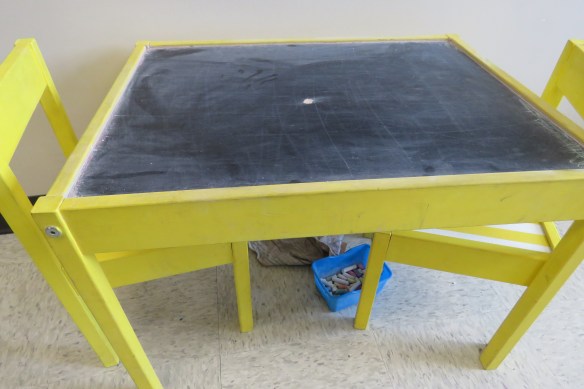Some days, when I have low energy, I don’t feel up to mixing buckets of paint, although I believe strongly that the more our kids enjoy the tactile/sensory/exquisitely beautiful experience of paint, the better. Last night I tossed around and couldn’t get myself to sleep. I did warm milk and read way too many pages in that book over there.
So, this morning, early, I decided that I would focus on some drawing skills with Courtney’s grade threes.
I stepped into Courtney’s classroom and was in love. I felt that the space said immediately, “Welcome. You are here. You are safe. This is how we have a lovely time learning.” Thanks for that feeling, Courtney. While I’m still waiting for permission to post these photos, I’m going to go ahead anyway…always good to share generously with our colleagues, in the case that they can pick up some ideas for another year.
Chalk board and chalk…two wee chairs…love this! Students can play school and practice their math facts and making words. Coo-ell!

Word walls! They never go out of fashion! I like that the children’s script is present and that these are not stylishly created by the teacher or an assistant. Ownership! Whoot!
Oh my goodness! Art created based on a book I’ve never connected with! The Day the Crayons Quit by Drew Daywalt Pictures by Oliver Jeffers. I like the book! I like the follow-up art work!
The seven habits…we all need to check in with these.
Set the students up to go into role! Group drama, even if it is simple as the labels we use, can make the difference in engagement that we want. I always refer to the students as artists during art class. Confidence forming…I like this chart and reminder.
Way to curb some situational drama. It’s good for kids to check in before speaking. But, it’s just as important for adults. Love this!
One of the best Hall Pass systems out there! I’ve never seen this done before! When the student leaves the classroom, they leave the hand sanitizer on their desks…when they return, voila! (just in case they forgot)
Look at that voice level chart…yummy!
Who doesn’t enjoy words to live by? I live by them!
Our morning art lesson began after greetings and opening exercises.
Recently, I’ve connected with a friend-blogger, Miriam Paternoster, who teaches middle school art in North Italy, and in perusing her lesson ideas, I decided that I’d try out something with my grade threes.
In the grade three social studies curriculum, the students explore Peru, Ukraine, India and Tunisia. I remembered the rich tiling and mosaic motifs that come out of all of these regions and so decided to focus the children on creating tiles that can be linked together for display purposes. In order to inspire pattern-making for the ‘doodled’ sections, it’s good to give many exemplars. When the question, “What is a tile?” came up, there was a lot of discussion about the tiles in our homes.
New vocabulary: tiling and motifs.
I printed off templates on large white paper before coming down to the classroom in the morning. I ticked off six dots on each side of a measured square/ 11 x 17 paper through the copy machine…so, 11″ squares. These templates provided markers for the grade three students to draw their six woven strands of ribbon. (dot-to dot across from one another) Where things had to be thoughtfully done was deciding what particular lines needed to be erased so that the ribbons wove through the piece…I referred to them as ‘unders’ and ‘on tops’.
Once blocked in, the ribbons were shaded at all the ‘unders’. I taught the grade threes how to apply different pressure with their pencils to go ‘dark and lighter and lighter and lighter’. I also taught them how to avoid making ‘hairy’ edges, but turning their pencil sideways and making marks along a line edge. Did I think they would do this? I wondered. And yet, there was barely a peep as they invested their energy in creating these drawings.
The expressive component of the lesson was to choose a single coloured thin marker to create repeating and varied motifs in all of the remaining white negative spaces. We worked on a community piece on the white board as the independent work was happening. “If you invent a pattern that you want to share, you can add it at the white board.” This is what they created.
The list of statements to the right side of the white board are questions that students might ask instead of, “Is this good?”
Here are some of the resulting projects.
Students who are older would not require a template for the woven ribbons.
From Miriam’s website…when displaying these, connect the dots and create a collection of tiles.
Thank you for your class today, Courtney!